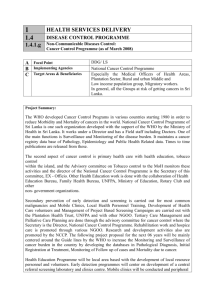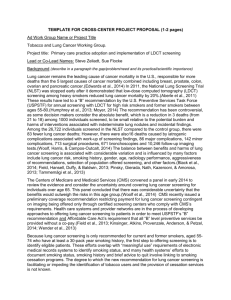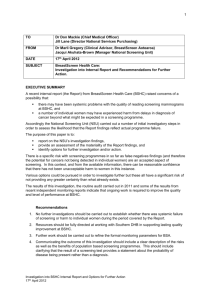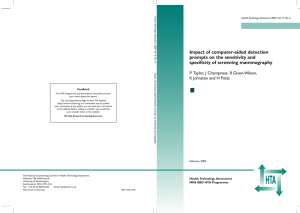TWO EXAMPLES Discuss the arguments for and against screening
advertisement
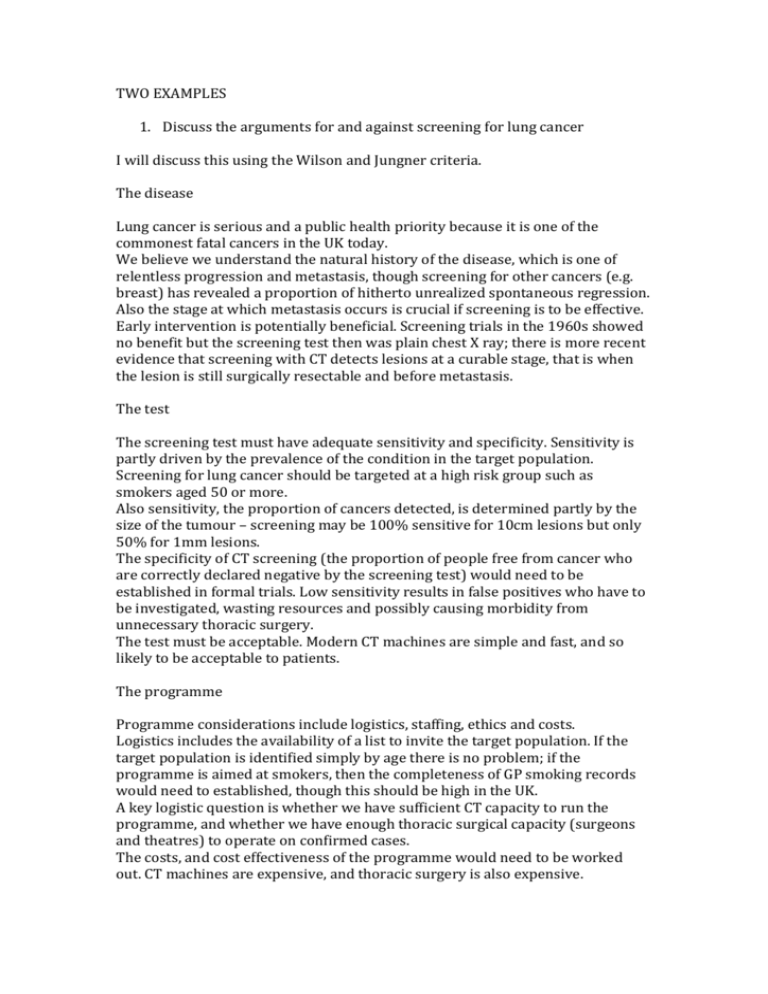
TWO EXAMPLES 1. Discuss the arguments for and against screening for lung cancer I will discuss this using the Wilson and Jungner criteria. The disease Lung cancer is serious and a public health priority because it is one of the commonest fatal cancers in the UK today. We believe we understand the natural history of the disease, which is one of relentless progression and metastasis, though screening for other cancers (e.g. breast) has revealed a proportion of hitherto unrealized spontaneous regression. Also the stage at which metastasis occurs is crucial if screening is to be effective. Early intervention is potentially beneficial. Screening trials in the 1960s showed no benefit but the screening test then was plain chest X ray; there is more recent evidence that screening with CT detects lesions at a curable stage, that is when the lesion is still surgically resectable and before metastasis. The test The screening test must have adequate sensitivity and specificity. Sensitivity is partly driven by the prevalence of the condition in the target population. Screening for lung cancer should be targeted at a high risk group such as smokers aged 50 or more. Also sensitivity, the proportion of cancers detected, is determined partly by the size of the tumour – screening may be 100% sensitive for 10cm lesions but only 50% for 1mm lesions. The specificity of CT screening (the proportion of people free from cancer who are correctly declared negative by the screening test) would need to be established in formal trials. Low sensitivity results in false positives who have to be investigated, wasting resources and possibly causing morbidity from unnecessary thoracic surgery. The test must be acceptable. Modern CT machines are simple and fast, and so likely to be acceptable to patients. The programme Programme considerations include logistics, staffing, ethics and costs. Logistics includes the availability of a list to invite the target population. If the target population is identified simply by age there is no problem; if the programme is aimed at smokers, then the completeness of GP smoking records would need to established, though this should be high in the UK. A key logistic question is whether we have sufficient CT capacity to run the programme, and whether we have enough thoracic surgical capacity (surgeons and theatres) to operate on confirmed cases. The costs, and cost effectiveness of the programme would need to be worked out. CT machines are expensive, and thoracic surgery is also expensive. Another consideration is potential harms of the programme, particularly from the radiation exposure in CT scanning. ------------------------------------------------------------------------------------------------2. Discuss the health effects of global warming The World Health Organisation has defined health as a state of complete physical, mental and social wellbeing. Physical health Global warming will melt the polar icecaps, raising sea levels everywhere. This will lead to flooding in coastal areas, particularly in south east Asia where there are several cities such as Kolkata which are coastal. Flooding in Bangladesh and Thailand has caused great loss of life in recent years. In addition global warming is thought likely to increase the frequency of extreme weather such as droughts and storms. Crop failures will make things even worse in areas which already suffer from malnutrition. Warming may increase the range of insect vectors for diseases such as malaria and typhus. Increased sunshine in temperate areas may increase the incidence of sunsensitive cancers such as melanoma and squamous carcinoma of the skin, unless preventive campaigns are effective. Heatwaves can increase mortality, particularly among the frail elderly, as was seen in the Chicago heatwave. On the other hand more sunshine may reduce the prevalence of vitamin D deficiency and rickets which are increasingly prevalent in some parts of the UK. Also, warmer winters may reduce excess winter mortality, which is a particular problem in the UK (though its relationship to temperature is not entirely clear). Mental health Damage to crops and livelihoods, and the direct effect of destruction by storm and flood will increase depression and anxiety. Even in England, severe flooding in Bristol in the 1950s had a measureable adverse effect on mental health. The current flooding in the Somerset levels is likely to have the same effect. [.] Social health Displacement of large numbers of refugees is likely with drought or flooding. The social consequence includes disruption of families as the more mobile members (typically the young men) move to more affluent countries, while women, children and old people remain in refugee camps. On the other hand, shared adversity, if not catastrophic, can produce strong bonding which may increase a sense of identity and social capital.







